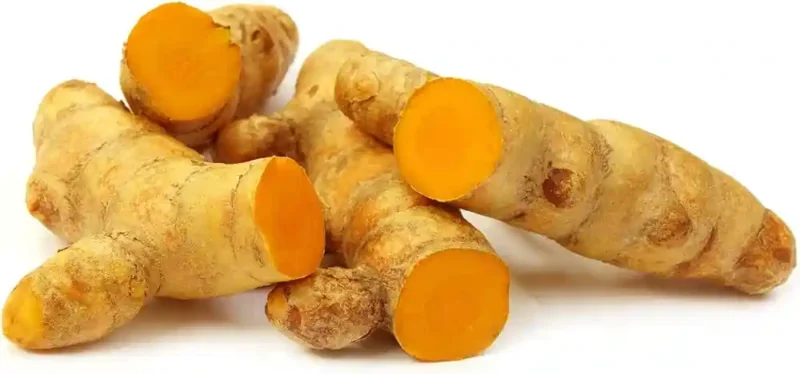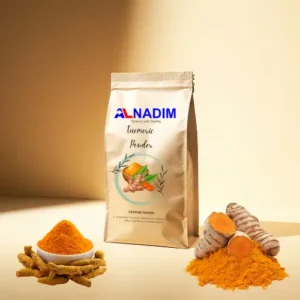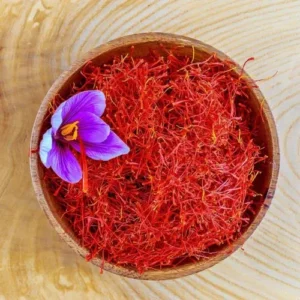Best Organic Turmeric : Nature’s Golden Spice
Experience the pure, earthy goodness of organic turmeric, a versatile spice known for its vibrant color and health benefits.
Our organic turmeric is sourced from sustainable farms and is free from harmful chemicals and pesticides. It is carefully hand-picked and dried to preserve its natural flavor and potency.
Key Features:
- Organic: Grown without the use of synthetic pesticides or fertilizers.
- High Quality: Carefully selected for its vibrant color, earthy aroma, and strong flavor.
- Versatile: Can be used in a variety of culinary applications.
- Health Benefits: Rich in curcumin, a powerful antioxidant with numerous health properties.
Uses in Cuisine:
- Curries: A staple ingredient in Indian and other South Asian cuisines.
- Masalas: Used in various spice blends for flavor and color.
- Pickles: Adds a unique tangy flavor.
- Beverages: Enjoy as a golden milk latte or turmeric tea.
- Cooking: Can be added to rice, soups, and stews for a subtle flavor and vibrant color.
Elevate your dishes with the natural goodness of organic turmeric.
Organic and Tested Turmeric Supplier for India is ALNDIM EXIM LLP
BEST QULITY OF Turmeric Supplier for India is ALNDIM EXIM LLP.
Whole Turmeric Recipe: A Simple and Flavorful Dish
Ingredients:
- 1 cup whole turmeric rhizomes
- 1 tablespoon coconut oil
- 1 teaspoon cumin seeds
- 1/2 teaspoon mustard seeds
- 1 dried red chili pepper
- 1 bay leaf
- 1 cup water
- Salt to taste
Instructions:
- Prepare the turmeric: Scrub the turmeric rhizomes under running water to remove any dirt or debris. Peel off the outer skin and cut the turmeric into small pieces.
- Heat the oil: Heat the coconut oil in a saucepan over medium heat.
- Temper the spices: Add the cumin seeds, mustard seeds, and dried red chili pepper to the hot oil. Allow the spices to crackle and sizzle.
- Add turmeric: Stir in the turmeric pieces and bay leaf.
- Simmer: Pour in the water and bring to a simmer. Reduce heat and allow the turmeric to cook for 10-15 minutes, or until tender.
- Season: Remove the bay leaf and season with salt to taste.
- Serve: Serve the cooked turmeric as a side dish or use it as a base for other dishes.
Tips:
- For a stronger flavor, increase the cooking time.
- You can add other spices, such as cloves or cardamom, to the tempering step.
- Serve the cooked turmeric with rice, dal, or roti.
Enjoy this simple and flavorful whole turmeric recipe!
Indian Turmeric: A Global Golden Treasure for Best Organic Turmeric
Indian Turmeric: A Taste of Tradition and Health
Turmeric, the golden spice that has been revered for centuries in India, has gained worldwide recognition for its unique flavor, vibrant color, and remarkable health benefits. India, with its rich agricultural heritage, produces some of the finest quality turmeric in the world.
Why Indian Turmeric is Best
- Climate and Soil: India’s tropical climate and fertile soil provide the ideal conditions for cultivating turmeric. The combination of abundant rainfall and well-drained soil contributes to the production of high-quality turmeric rhizomes.
- Traditional Cultivation Practices: Indian farmers have been cultivating turmeric for generations, passing down their knowledge and expertise. Traditional cultivation methods, often involving organic practices, help preserve the natural qualities of the spice.
- Variety and Quality: India produces a wide range of turmeric varieties, each with its own distinct characteristics. From the fiery-hot turmeric of Kerala to the milder varieties of Andhra Pradesh, Indian turmeric offers a diverse palette of flavors and aromas.
- Health Benefits: Turmeric is renowned for its medicinal properties, primarily due to its curcumin content. Curcumin is a powerful antioxidant and anti-inflammatory compound that has been linked to various health benefits, including improved digestion, reduced inflammation, and enhanced brain function.
- Culinary Versatility: Indian turmeric is a versatile spice that can be used in a variety of dishes. From curries and masalas to pickles and beverages, turmeric adds depth, color, and flavor to countless culinary creations.
A Kaleidoscope of Turmeric: Exploring Different Varieties
Turmeric, the golden spice that has captivated the world, comes in various forms, each with its own unique characteristics. Here are some of the most common varieties of turmeric:
1. Fingerroot Turmeric (Curcuma zanthorrhiza)
- Appearance: Long, slender rhizomes with a ginger-like shape.
- Flavor: A slightly bitter taste with a hint of citrus.
- Usage: Often used in Southeast Asian cuisine, particularly in Thai dishes.
2. White Turmeric (Curcuma zedoaria)
- Appearance: White or pale yellow rhizomes.
- Flavor: A milder, sweeter taste compared to yellow turmeric.
- Usage: Used in traditional medicine and as a flavoring agent in some cuisines.
3. Black Turmeric (Curcuma caesia)
- Appearance: Dark, almost black rhizomes.
- Flavor: A slightly bitter taste with a hint of earthiness.
- Usage: Used in traditional medicine and as a natural dye.
4. Red Turmeric (Curcuma longa var. rubra)
- Appearance: Red or reddish-purple rhizomes.
- Flavor: Similar to yellow turmeric but with a slightly different aroma.
- Usage: Used in cooking and traditional medicine.
5. Yellow Turmeric (Curcuma longa)
- Appearance: Yellow rhizomes.
- Flavor: A slightly bitter taste with a warm, earthy aroma.
- Usage: The most common type of turmeric used in cooking and traditional medicine.
Note: These are just a few of the many turmeric varieties available. The specific characteristics, including flavor, aroma, and appearance, can vary depending on factors such as growing conditions and cultivation practices.
A Deeper Dive into Yellow Turmeric
Yellow turmeric, or Curcuma longa, is the most commonly used variety of turmeric worldwide. It’s prized for its vibrant color, earthy aroma, and unique flavor.
Key Characteristics:
- Rhizomes: Typically yellow or orange in color, with a slightly bitter taste and a warm, earthy aroma.
- Curcumin: Contains curcumin, a powerful antioxidant and anti-inflammatory compound that has been extensively studied for its potential health benefits.
- Versatility: Can be used in a wide range of culinary applications, from curries and masalas to pickles and beverages.
Culinary Uses:
- Curries: A staple ingredient in Indian, Thai, and other South Asian cuisines.
- Masalas: Used in various spice blends for flavor and color.
- Pickles: Adds a unique tangy flavor.
- Beverages: Enjoy as a golden milk latte or turmeric tea.
- Cooking: Can be added to rice, soups, and stews for a subtle flavor and vibrant color.
Health Benefits:
While more research is needed, turmeric has been shown to have potential health benefits, including:
- Anti-inflammatory properties: May help reduce inflammation associated with conditions like arthritis.
- Antioxidant properties: Can help protect cells from damage caused by free radicals.
- Improved digestion: May aid in digestion and relieve symptoms of indigestion.
- Brain health: Some studies suggest turmeric may have benefits for brain health, including memory and cognitive function.
Turmeric in Your Kitchen: Tips and Recipes
Turmeric is a versatile spice that can add depth, color, and flavor to your dishes. Here are some tips on using turmeric in your cooking, along with a few recipe ideas:
Tips:
- Start small: Begin with a small amount of turmeric and gradually increase to your desired flavor.
- Combine with other spices: Turmeric pairs well with other spices like cumin, coriander, and chili powder.
- Toast for deeper flavor: Toasting turmeric before using it can enhance its flavor and aroma.
- Use in marinades: Add turmeric to marinades for meats, poultry, or fish to tenderize and flavor.
- Create golden milk: Make a soothing golden milk latte by combining turmeric with milk, honey, and a pinch of black pepper.
Recipes:
- Chicken Tikka Masala: A classic Indian curry dish featuring tender, marinated chicken in a creamy tomato sauce.
- Turmeric Rice: A simple and flavorful side dish that can be enjoyed on its own or as a base for other dishes.
- Golden Milk Latte: A comforting and healthy beverage made with turmeric, milk, honey, and a pinch of black pepper.
- Turmeric Pickled Vegetables: A tangy and flavorful condiment that can be enjoyed with meals or as a snack.
- Turmeric-Roasted Vegetables: A colorful and nutritious side dish that can be customized with your favorite vegetables.
The inconceivable Benefits of Organic Turmeric
Turmeric, the golden- hued spice, has been celebrated for centuries not only for its vibrant color and distinct flavor but also for its remarkable health benefits. Organic turmeric is particularly prized as it’s free from dangerous chemicals and fungicides, making it the purest form available. In this comprehensive companion, we claw deep into the astonishing benefits of organic turmeric and how it can ameliorate overall well- being.
Why Choose Organic Turmeric?
Organic turmeric is cultivated without synthetic diseases, fungicides, or genetically modified organisms( GMOs), icing that you admit the loftiest- quality product packed with curcumin , the active emulsion responsible for utmost of its health benefits. When compared tonon-organic kinds, organic turmeric boasts a richer nutritive profile and lesser chastity.
1. Anti-Inflammatory parcels
One of the most well- proved benefits of organic turmeric is its anti-inflammatory goods . habitual inflammation is linked to multitudinous conditions, including heart complaint, cancer, and arthritis. Curcumin , the primary active emulsion in turmeric, has been scientifically proven to reduce inflammation by blocking NF- kB, a patch that plays a crucial part in seditious pathways.
Particular Experience with Turmeric for Inflammation
For times, I plodded with common pain due to arthritis. After incorporating organic turmeric into my diet daily, I noticed a significant reduction in pain and stiffness. Unlike conventional specifics that came with side goods, turmeric handed me with a natural, effective result.
2. Boosts Immune System
Regular consumption of organic turmeric strengthens the vulnerable system , helping the body fight off infections and ails. Curcumin enhances the exertion of vulnerable cells, making it an excellent natural remedy for snap, flu, and other infections.
How I Used Turmeric for impunity
After suffering from frequent snap, I began drinking turmeric tea every morning. Within a many months, I noticed a drop in the frequence of my ails. It was clear that organic turmeric had strengthened my impunity naturally.
3. Supports Digestive Health
Organic turmeric has been used for centuries as a digestive aid. It stimulates corrosiveness product, enhances nutrient immersion, and helps reduce symptoms of bloating, gas, and indigestion.
My trip to Better Digestion with Turmeric
I had patient issues with indigestion and bloating after refections. After adding organic turmeric to my diet, I endured bettered digestion and felt lighter after eating. Now, I sprinkle a little turmeric in my refections to maintain a healthy gut.
4. Promotes Heart Health
Turmeric supports heart health by perfecting rotation, reducing cholesterol situations, and precluding blood clots. Studies suggest that curcumin helps lower the threat of heart complaint by perfecting the function of the endothelium, the filling of blood vessels.
particular Experience with Heart Health
After my croaker
advised me about high cholesterol situations, I started taking organic turmeric supplements. Within six months, my cholesterol situations bettered significantly, and I felt more energetic and active.
5. A Natural Remedy for Skin Conditions
Organic turmeric is a hustler for skin health. Its antioxidant and anti-inflammatory parcels help combat acne, eczema, and psoriasis while promoting a radiant complexion.
Turmeric for Glowing Skin
I suffered from acne flights for times. After applying a turmeric face mask mixed with honey and yogurt, I saw visible advancements within weeks. My skin came clearer and further vibrant, proving turmeric’s inconceivable benefits for skincare.
6. Supports Brain Health and Cognitive Function
exploration suggests that curcumin enhances brain function by boosting situations of Brain- deduced Neurotrophic Factor( BDNF), which supports neuron growth and prevents neurodegenerative conditions like Alzheimer’s.
My Cognitive Boost with Turmeric
As I aged, I started passing occasional obliviousness. Incorporating organic turmeric into my diet helped edge my memory and ameliorate my focus. It felt like a natural brain supporter without any side goods.
7. Aids in Weight Loss and Metabolism
still, organic turmeric can be a great addition to your diet, If you’re floundering with weight operation. Curcumin helps regulate metabolism, reduces fat towel growth, and enhances fat- burning processes.
Turmeric for Weight Loss
After floundering with weight loss for times, I started drinking turmeric tea before refections. Over time, I noticed better digestion, reduced jones
, and a gradational yet steady weight loss without drastic diet changes.
8. Natural Pain Reliever
Studies have shown that organic turmeric can be as effective as some pain specifics in easing pain, particularly for conditions like arthritis, muscle soreness, and migraines.
How Turmeric Helped My Chronic Pain
I had recreating migraines that frequently left me incapacitated. rather of counting on anodynes, I tried turmeric supplements , and they worked prodigies in reducing the frequence and intensity of my headaches.
9. Helps Regulate Blood Sugar situations
For those managing diabetes or prediabetes, organic turmeric can help stabilize blood sugar situations and ameliorate insulin perceptivity.
Personal Story Managing Blood Sugar
After being diagnosed with prediabetes, I made salutary changes, including adding organic turmeric to my refections. Over time, my blood sugar situations came more stable, and I avoided the need for drug.
10. Detoxifies the Liver
Organic turmeric supports liver function by stimulating detoxification enzymes, reducing oxidative stress, and guarding against liver conditions.
Turmeric for Liver Detox
After times of unhealthy eating, I wanted to cleanse my system. Drinking turmeric- invested water daily made a conspicuous difference in my energy situations and overall health.
How to Incorporate Organic Turmeric into Your Diet ?
– Golden Milk A soothing drink made with turmeric, milk, and honey.
– Turmeric Tea A warm, comforting tea with bomb and gusto.
– Turmeric Smoothies Blend with fruits and almond milk for a nutritional boost.
– Turmeric Supplements Accessible for those who need a advanced curcumin input.
– Cooking Add to mists, stews, curries, and salads.
Final studies
The benefits of organic turmeric are vast, making it a must- have addition to any heartiness routine. Whether you’re looking to reduce inflammation, boost impunity, ameliorate digestion, or promote heart health , this golden spice is a important natural remedy. By choosing organic turmeric , you insure that you’re entering all the health benefits without dangerous chemicals.
Turmeric-Roasted Vegetables
Ingredients:
- 1 pound mixed vegetables (such as carrots, potatoes, Brussels sprouts, broccoli)
- 1 tablespoon olive oil
- 1 teaspoon ground turmeric
- 1/2 teaspoon ground cumin
- 1/4 teaspoon salt
- 1/4 teaspoon black pepper
Instructions:
- Preheat oven to 400°F (200°C).
- Cut vegetables into bite-sized pieces.
- In a large bowl, combine vegetables, olive oil, turmeric, cumin, salt, and pepper. Toss to coat.
- Spread the vegetables in a single layer on a baking sheet.
- Roast for 20-25 minutes, or until tender and slightly browned.
- Serve hot and enjoy.
For added flavor, you can drizzle the roasted vegetables with a lemon-tahini sauce or sprinkle with chopped fresh herbs.
Conclusion
Indian turmeric is a global treasure, prized for its quality, flavor, and health benefits. With its rich history, diverse varieties, and traditional cultivation practices, India continues to be the world’s leading producer of this golden spice. Whether you’re a home cook or a professional chef, incorporating Indian turmeric into your recipes is a delicious and healthy choice.




















Reviews
There are no reviews yet.